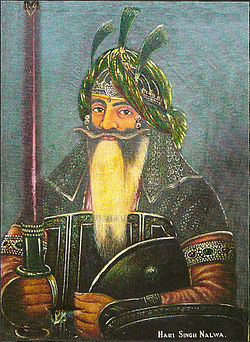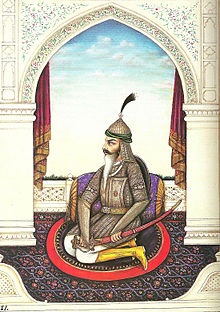- Hari Singh Nalwa
-
Hari Singh Nalwa 
Nickname Bag Mar[1]
(Tiger-Killer)Born 1791
GujranwalaDied 1837
JamrudAllegiance Sikh Empire Years of service 1807-1837 Rank General
Commander-in-chief dates needed hereCommands held Governor of Kashmir (1820)[2]
Governor of Multan (1822)[2]
Governor of Peshewar (1834)[2]Battles/wars Battle of Jamrud Hari Singh Nalwa (Punjabi: ਹਰੀ ਸਿੰਘ ਨਲਵਾ) (1791–1837) was Commander-in-chief of the Khalsa, the army of the Sikh Empire. He is known for his role in the conquests of Kasur, Sialkot, Multan, Kashmir, Attock, and Peshawar. He led the Sikh Army in freeing Shah Shuja from Kashmir and secured the Koh-i-Nor diamond for Maharaja Ranjit Singh. His death at the Battle of Jamrud was a significant loss to the Sikh Empire.
He was responsible for expanding the frontier of Sikh Empire to the Indus River. In 1831, he opposed moves by Ranjit Singh to appoint Kharak Singh as his successor as Maharaja of the Sikh Empire.[3] At the time of his death, the western boundary of the Sikh Kingdom was Jamrud. His frontier policy of holding the Khyber Pass was later used by the British Raj.
He served as governor of Kashmir and Hazara and established a mint on behalf of the Sikh Empire to facilitate revenue collection.
Contents
Early life
Hari Singh's ancestors came to Majitha and served the Sukerchakia Misl. His grandfather, Hardas Singh, was killed in action in 1762. His father, Gurdial Singh, served under Charat Singh and Maha Singh as a Risaldar and received the Jagir of Balloki, a village in the modern day Kasur District of Pakistan.[3]
Hari Singh Nalwa was born into an Uppal Khatri family, in Gujranwala, Punjab to Gurdas Singh uppal and Dharam Kaur.[4] After his father died in 1798, he was raised by his mother with help from his uncle. His mother fought off attempts to seize the family's Jagir after his father's death. In 1801, at age ten, he took Amrit Sanskar and was baptized as a Sikh.[5] At the age of twelve, he began to manage his father's estate and took up horseriding.
In 1804, at the age of fourteen, his mother sent him to Ranjit Singh's court to resolve a property dispute.[5] Ranjit Singh decided the arbitration in his favour and asked him about his background. Hari Singh explained that his father and grandfather had served under Maha Singh and Charat Singh, the Maharaja's ancestors, and demonstrated his skills as horseman and musketeer.[5] Ranjit Singh gave him a position at the court as a personal attendant.
Military career
His military career began in 1804 on a hunting trip. At some time during the hunt, he was temporarily separated from the hunting party and a lion attacked him, killing his horse. The rest of the hunters found him but he refused their attempts to protect him and killed the lion by himself with a shield and short sword.[1] Ranjit Singh rewarded him with a commission as Sardar and the command of 800 cavalry.
Sir Henry Griffin called Nalwa the "Murat of the Khalsa". A British newspaper had asserted in the early twentieth century that had Nalwa possessed the resources and the artillery of the British, he would have conquered the East and extended the boundaries of the Sikh Kingdom to include Europe.[6][7][8][9] He participated in the conquests of Sialkot, Kasur (1807), Multan (1818), Kashmir (1819), Pakhli and Damtaur (1821-2), Peshawar (1834)[10] and finally Jamrud in the Khyber Hills (1837).[11] He defeated the Afghans, something the British failed to do, and annexed a segment of what was the Kingdom of Kabul to the Sikh Kingdom. In Peshawar, he rebuilt the Bala Hisar Fort in Ranjit Singh's name.
Hari Singh served as the governor of both Kashmir and Peshawar. A coin minted in Kashmir came to be known as the 'Hari Singhee'.[12] The coin is on display in museums.
Legacy
Haripur city, tehsil and district, in Hazara, North-West Frontier Province, Pakistan, are named after him.[13]
His descendants live in India and abroad. This runs counter to the story of Maharajah Ranjit Singh's line, which was forever destroyed by the British, who abducted his children and took them to England, where they were held hostage against the threat of India rising against British rule.
Nalwa was the most senior member of Ranjit's court. His son, Jawahir Singh, led the famous charge at the Battle of Chillianwala, a battle in which the British were forced to retreat.[14] Another son, Arjan Singh, also posed a tough challenge to the British as they struggled to annex the Punjab.[15]
Plaudits
A very popular 19th century British newspaper, Tit-Bits, made a comparative analysis of great generals of the world and arrived at the following conclusion:
"Some people might think that Napoleon was a great General. Some might name Marshal Hindenburgh, Lord Kitchener, General Karobzey or Duke of Wellington etc. And some going further might say Halaku Khan, Genghis Khan, Changez Khan, Richard or Allaudin etc. But let me tell you that in the North of India a General of the name of Hari Singh Nalwa of the Sikhs prevailed. Had he lived longer and had the sources and artillery of the British, he would have conquered most of Asia and Europe…."[16]
Hari Singh Nalwa's meeting with various British travellers and a German are recorded. Baron Charles von Hügel remembers him fondly in his memoirs. He met the Sardar at his residence in Gujranwala. On that occasion the German was gifted a portrait of Nalwa in the act of killing a tiger. Hari Singh Nalwa was fluent in the Persian language. He was also conversant with Punjabi, Gurmukhi script and Pushtu, the latter being the language of the Pashtuns. He was familiar with world politics, including details about the European states.
Accolades continued to be delivered long after Sardar Hari Singh Nalwa's death.[17] Pannikar sums him up as "The noblest and the most gallant of the Sikh generals of his time, the very embodiment of honour, chivalry, and courage…" [18]
For decades after his death, Yusufzai women would say Raghe Hari Singh ("Hari Singh is coming") to frighten their children into obedience.[19]
See also
References
- ^ a b Sandhu (1935), p.4
- ^ a b c Singhia (2009), p.96
- ^ a b Sandhu (1935), p.1
- ^ http://www.harisinghnalwa.com/family_tree.html
- ^ a b c Sandhu (1935), p.2
- ^ Giani Gurmukh Singh Musafar[Full citation needed]
- ^ Phulwari, March 1934
- ^ Hoti, Prem Singh (1937/1950). Jivan-itihas Sardar Hari Singh ji Nalua - Life of the Sikh General Hari Singh Nalua (7th ed.). Amritsar: Lahore Book Shop (Gurmukhi). pp. 356–9.
- ^ A Bibliography of the Punjab. Patiala: Patiala University. 1966. p. 199.
- ^ http://www.harisinghnalwa.com/general.html
- ^ http://www.harisinghnalwa.com/final_frontier.html
- ^ http://www.harisinghnalwa.com/index.html
- ^ Tehsils & Unions in the District of Haripur - Government of Pakistan
- ^ Nalwa (2009), pp. 279-80
- ^ Nalwa (2009), pp. 278-9
- ^ [1]
- ^ http://www.harisinghnalwa.com/accolades.html
- ^ K.M. Panikkar in The Founding of the Kashmir State, 1930 (Historian, Author, Diplomat and Editor, Hindustan Times, 1925)
- ^ Allen, Charles (2000). Soldier Sahibs. Abacus. p. 30. ISBN 0-349-11456-0.
Bibliography
- Sandhu, Autar Singh (1935). General Hari Singh Nalwa. Lahore: Cunningham Historical Society. http://www.apnaorg.com/books/english/hari-singh-nalwa/book.php?fldr=book.
- Nalwa, Vanit (2009). Hari Singh Nalwa - Champion of the Khalsaji. New Delhi: Manohar Books. ISBN 8173047855.
- Singhia, H.S. (2009). The encyclopedia of Sikhism. New Delhi: Hemkunt Press. ISBN 978-8170103011. http://books.google.com/books?id=gqIbJz7vMn0C&pg=PA111&dq=jassa+singh+ahluwalia&hl=en&ei=vFnnS8C6Doq2NtaDjNQE&sa=X&oi=book_result&ct=result&resnum=2&ved=0CDcQ6AEwAQ#v=onepage&q&f=false.
External links
Categories:- Haripur District
- Indian Sikhs
- Sikh warriors
- 1791 births
- 1837 deaths
Wikimedia Foundation. 2010.

